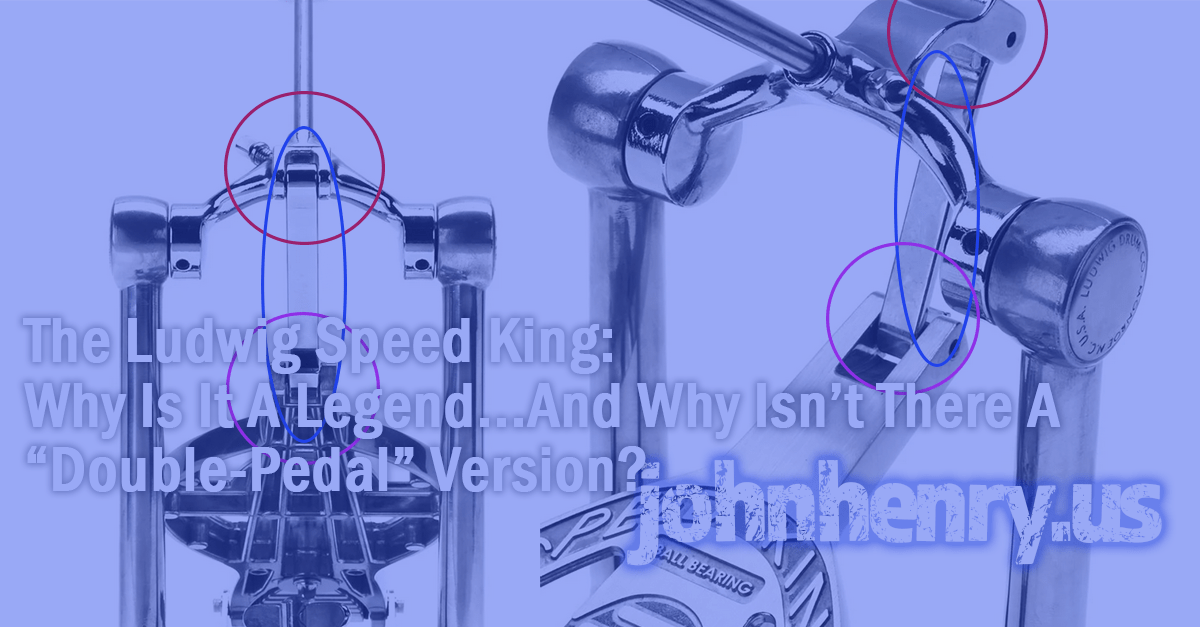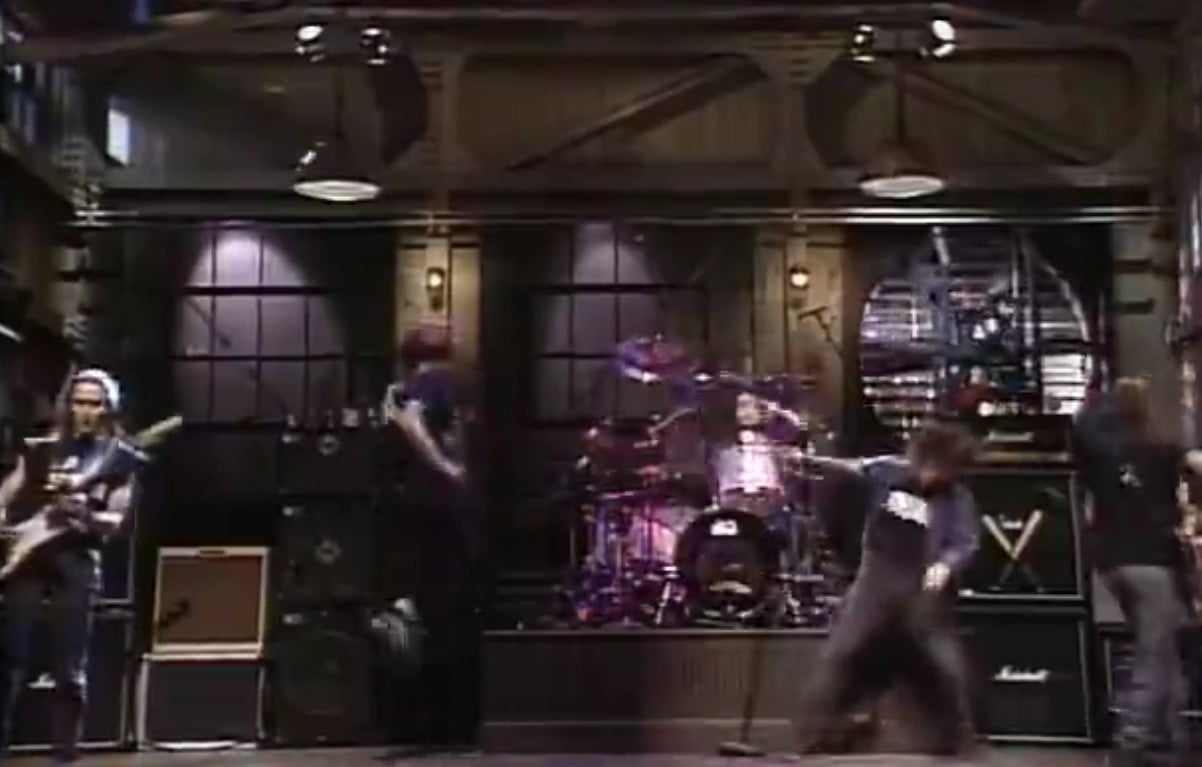[Edit, Feb ’24: Pearl have released a very interesting take on this concept, which you can find at https://www.musiciansfriend.com/accessories/pearl-eliminator-demon-drive-double-pedal and https://www.musiciansfriend.com/accessories/pearl-p3502d-demon-xr-direct-drive-double-bass-drum-pedal. Both of these are “direct drive” pedals, and both were – in an interesting bit of synchronicity – released around the same time I was writing this article – closely enough that I didn’t know about them yet, but also hadn’t been watching closely and frankly didn’t think to look, as it’s long been a closed case in drums.
I’ll update this a bit more when the site rebuild is done.]
For my regular audience this article’s a bit of a departure from norm (and is probably the sort of thing I should’ve been doing more of when I was working at Musician’s Friend in the late 2010s!), but we’re going to take a look at a legendary bit of music equipment and its list of idiosyncrasies, and then explore the ultimate question: why has there never been a double Speed King pedal?
For drummers that question will make sense and most of them will probably know the answer instinctively, but it’s an interesting set of observations, an interesting (and unsolved) engineering problem, and a fun bit of music history that I’m very well acquainted with as my first bass drum pedal was a Speed King, and I played it for about a decade as I was coming up. Very familiar with it, and it’s such a unique bit of work that its little tricks and trials tend to stay with you. (Note the navigation, it’s a multi-page article.)
But. It’s worth pointing out that the linkage has been considerably beefed up over the years; the model I played, which was probably made in the mid-70s, the linkage bar between the pedal and camshaft was much thinner metal. It still didn’t bend, mind you, but it wasn’t as heavy as it is now, and basically just slipped over the crosspins on either end, being stiff enough to flex just a bit to get them on with a snap, but not enough to bend while playing.
Problem is, over time with regular playing those rubbing parts start to wear and loosen up a bit. The bend spring that created the clips on each end would tend to lose their “closed” tension with repeated removals and re-attachments (easier to pack if it’s unhooked), and the movement of the pedal while playing has some impact too although these are REALLY well made and extremely durable. Unfortunately no matter how durable, occasionally you’re going to get a bit of rattling with all that metal-on-metal connection.
Additionally – and this is what the SK is really legendary for in terms of why people look at ’em sideways – there are ball bearings in the mounting points of the camshaft at the top of the “legs,” very similar to what you’ll find in the axle of a bicycle wheel for instance. With time and being thrown around and dragged around the country for a few years, they can dry out…and they’ll start squeaking.
There are classic, legendary tracks where you can actually hear the pedal squeaking on the recording. Some of those include “Come Go With Me” by the Del Vikings (where it’s so audible it sounds almost like a tambourine through contemporary playback equipment like a little record player or small radio), it’s picked up a bit on “Superstition” by Stevie Wonder, Moby Grape’s first album, a ton of James Brown cuts with Melvin Parker and/or Jabo Starks…and again, legendarily, on probably half of Led Zeppelin’s recorded catalogue, most notably (to me) the studio version of “Since I’ve Been Loving You,” “All My Love,” and “When The Levee Breaks.” Any drummer who does serious work with a speed king carries some kind of lubricating oil with them, because when it starts it will NOT stop until you do something.
It’s also worth noting that the body of the SK is made of cast metal, and occasionally metal casting creates an object that may have a minor flaw or weak spot in it that might never be noticed e.g. in a kitchen pan, but when you’re using it as a lever from which to beat on something really hard a few million times, they can break.
One of the things that can break is the shaft that the mallet is mounted on. If you look at the photo above you’ll notice that there’s not a mechanical cam on a straight shaft as with other pedals. On the speed king, the entire shaft is cammed by being curved. That is the clue that brings us to our title question
Why Can’t The Speed King Be Doubled?
In short: it’s mechanically impossible to engineer a pedal with the features unique to the speed king that make it what it is, and still be able to manufacture it practically and with a level of reliability that is acceptable for commercial production.
It would in theory be possible to run an extension arm between two pedals, which is half the problem. The other half, however kills it. The mallets have to be able to move independently of each other. In order to do that with a Speed King, the only real option would be to split the camshaft where the mallets are mounted, one for left and one for right.
That would result in an extremely weak mounting point right where most of the impact force lands on the mechanism. You could likely compensate by going with a much heavier shaft or what have you, but to do that and still have a practical pedal that was durable and that you could manufacture at a sufficiently low cost to not have to charge more for the things than a good mid-range drum kit has, thus far, eluded the Ludwig company for about a century and a quarter now.
As an engineering problem, with the single mallet setup you have all the impact stress going through the mallet rod into the mounting bar, which is a nice, solid piece of metal that’s taking the majority of pressure at the “top” of the arc in that bar (I’m sure I don’t have to explain the strength of arches to an engineer), the kinetic energy is dissipated more or less evenly across the piece from center.
With a double mallet setup on a split shaft, the pressure is all at the “split” end of the shaft, and it’s not even reinforced. Not too hard to see that in this configuration the mount shafts would bend and/or break constantly. While in theory one can envision a sort of “M” design like the McDonalds logo, with a mallet at the top of each, I’m gonna go ahead and give the company that’s been making them for a hundred years credit for having already considered that and found it an inadequate solution for one reason or another, again probably relating to the practicality of manufacturing the thing without it costing a mint. Given that Ludwig does in fact have a double-pedal and it’s not based on the SK design tends to validate that theory.
And that’s the story of what is probably the number one most famous bass drum pedal in history, and why it will almost certainly never been seen in a double-pedal configuration. Are you a drummer who’s used the Speed King pedal? What was your experience?













